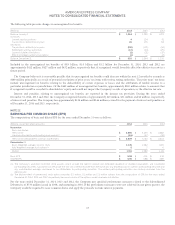American Express 2014 Annual Report Download - page 107
Download and view the complete annual report
Please find page 107 of the 2014 American Express annual report below. You can navigate through the pages in the report by either clicking on the pages listed below, or by using the keyword search tool below to find specific information within the annual report.AMERICAN EXPRESS COMPANY
NOTES TO CONSOLIDATED FINANCIAL STATEMENTS
VALUATION TECHNIQUES USED IN THE FAIR VALUE MEASUREMENT OF FINANCIAL ASSETS AND FINANCIAL LIABILITIES CARRIED AT
OTHER THAN FAIR VALUE
For the financial assets and liabilities that are not required to be carried at fair value on a recurring basis (categorized in the valuation
hierarchy table above) the Company applies the following valuation techniques to measure fair value:
Financial Assets For Which Carrying Values Equal or Approximate Fair Value
Financial assets for which carrying values equal or approximate fair value include cash and cash equivalents, Card Member receivables,
accrued interest and certain other assets. For these assets, the carrying values approximate fair value because they are short term in duration,
have no defined maturity or have a market-based interest rate.
Financial Assets Carried At Other Than Fair Value
Loans
Loans are recorded at historical cost, less reserves, on the Consolidated Balance Sheets. In estimating the fair value for the Company’s loans
the Company uses a discounted cash flow model. Due to the lack of a comparable whole loan sales market for similar credit card receivables
and the lack of observable pricing inputs thereof, the Company uses various inputs derived from an equivalent securitization market to
estimate fair value. Such inputs include projected income (inclusive of future interest payments and late fee revenue), estimated pay-down
rates, discount rates and relevant credit costs.
Financial Liabilities For Which Carrying Values Equal Or Approximate Fair Value
Financial liabilities for which carrying values equal or approximate fair value include accrued interest, customer deposits (excluding
certificates of deposit, which are described further below), Travelers Cheques and other prepaid products outstanding, accounts payable,
short-term borrowings and certain other liabilities for which the carrying values approximate fair value because they are short term in
duration, have no defined maturity or have a market-based interest rate.
Financial Liabilities Carried At Other Than Fair Value
Certificates of Deposit
Certificates of deposit (CDs) are recorded at their historical issuance cost on the Consolidated Balance Sheets. Fair value is estimated using a
discounted cash flow methodology based on the future cash flows and the discount rate that reflects the Company’s current rates for similar
types of CDs within similar markets.
Long-term Debt
Long-term debt is recorded at historical issuance cost on the Consolidated Balance Sheets adjusted for the impact of fair value hedge
accounting on certain fixed-rate notes and current translation rates for foreign-denominated debt. The fair value of the Company’s long-term
debt is measured using quoted offer prices when quoted market prices are available. If quoted market prices are not available, the fair value is
determined by discounting the future cash flows of each instrument at rates currently observed in publicly-traded debt markets for debt of
similar terms and credit risk. For long-term debt, where there are no rates currently observable in publicly traded debt markets of similar
terms and comparable credit risk, the Company uses market interest rates and adjusts those rates for necessary risks, including its own credit
risk. In determining an appropriate spread to reflect its credit standing, the Company considers credit default swap spreads, bond yields of
other long-term debt offered by the Company, and interest rates currently offered to the Company for similar debt instruments of
comparable maturities.
NONRECURRING FAIR VALUE MEASUREMENTS
The Company has certain assets that are subject to measurement at fair value on a nonrecurring basis. For these assets, measurement at fair
value in periods subsequent to their initial recognition is applicable if determined to be impaired. During the years ended December 31, 2014
and 2013, the Company did not have any material assets that were measured at fair value due to impairment.
107
























